- Primary Sidebar
- Getting a better handle on currency risk | McKinsey
- Getting a better handle on currency risk
This can sometimes cause volatility in the company's stock price.

For example, let's say a U. However, it's not just the assets on the balance sheet that would decline, but revenue and net income profit earned in euros would depreciate as well. As a result, a company's reported earnings can be lower due to exchange rate fluctuations leading to a poor quarterly performance and a declining stock price.
Translation risk tends to be higher in developing countries and emerging market economies. Oftentimes, these economies are not fully developed, and the political climate is unstable, which exacerbates the exchange rate volatility of the local currency. There are various financial products that companies can use to mitigate or reduce translation risk.
One of the most popular products is called a forward contract , which locks in an exchange rate for a period of time. The rate lock allows companies to fix the value of their foreign assets based on the forward contract's exchange rate. Companies that sell products overseas and earn foreign revenue can request that their foreign clients pay for goods and services in the company's home currency. As a result, the risk associated with local currency fluctuations would not be borne by the company but instead by the client who is responsible for making the currency exchange prior to conducting business with the company.
However, the policy of shifting the exchange rate risk onto a foreign customer can backfire, if the customer doesn't want to take on the exchange rate risk, and as a result, finds a local company to do business with instead.
Primary Sidebar
McDonald's Corporation MCD is the largest restaurant chain in the world and generates a significant portion of its earnings from international business. As a result, the restaurant chain must contend with translation risk on a quarterly basis considering the size and scope of the restaurants, assets, and revenue generated overseas. Below is a portion of the quarterly report, which shows the impact of currency translation exposure on the company's financial performance. Accessed Aug. Corporate Finance. Advanced Forex Trading Concepts.
Getting a better handle on currency risk | McKinsey
Financial Statements. Your Privacy Rights. To change or withdraw your consent choices for Investopedia. At any time, you can update your settings through the "EU Privacy" link at the bottom of any page.
These choices will be signaled globally to our partners and will not affect browsing data. We and our partners process data to: Actively scan device characteristics for identification. I Accept Show Purposes. Your Money. Personal Finance. Your Practice. Popular Courses. What Is Translation Risk? Key Takeaways Translation risk is the exchange rate risk associated with companies that deal in foreign currencies and list foreign assets on their balance sheets.
Companies with assets in foreign countries must convert the value of those assets from the foreign currency to the home country's currency. The risk that exchange rates could move adversely and depreciate the value of a company's foreign assets is called translation risk.
Article Sources. Investopedia requires writers to use primary sources to support their work. These include white papers, government data, original reporting, and interviews with industry experts. We also reference original research from other reputable publishers where appropriate.
You can learn more about the standards we follow in producing accurate, unbiased content in our editorial policy. Compare Accounts.
Getting a better handle on currency risk
The offers that appear in this table are from partnerships from which Investopedia receives compensation. Related Terms Currency Translation Definition Currency translation is the process of converting the financial results of a parent company's foreign subsidiaries into its primary currency. Secondly, the parent organization can also request for payment of the Ps 3,, the Mexican affiliate owes to it. These three steps can eliminate all transaction exposure.
Moreover, translation exposure will be diminished as well. The report shows that no translation exposure is associated with the Canadian dollar or the Swiss franc. The above exhibit indicates that there is still enough translation exposure with changes in the exchange rate of the Mexican Peso and the Euro against the U. There are two major methods for controlling this remaining exposure. These methods are: balance sheet hedge and derivatives hedge.
Translation exposure is not purely entity specific; rather, it is only currency specific. A mismatch of net assets and net liabilities creates it. A balance sheet hedge will eliminate this mismatch. A perfect balance sheet hedge will occur in such a case. A derivative product, such as a forward contract, can now be used to attempt to hedge this loss.
International Finance - Translation Exposure Advertisements. Previous Page. Next Page. Previous Page Print Page.
